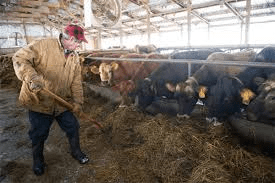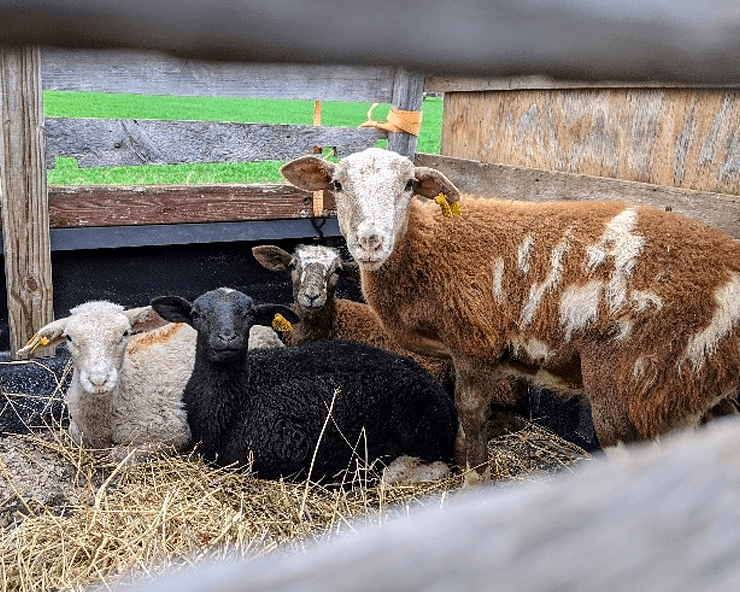Let us discuss how you can handle the introduction of new ruminant animals into your ruminant farm. Adding new ruminants to existing herds poses a certain amount of risk.
Make sure to check off the important information prior to purchasing because as a farmer, you have a duty to prevent the spread of disease between animals, from animals to humans, and from humans to animals.
Livestock farming can simply be defines as raising of animals for use or for pleasure. In this article, the discussion of livestock includes both beef and dairy cattle, pigs, sheep, goats, horses, mules, asses, buffalo, and camels; the raising of birds commercially for meat or eggs (i.e., chickens, turkeys, ducks, geese, guinea fowl, and squabs) is treated separately.
Please note that from whatever source they are coming from, it is not advisable that you introduce new animals directly into your ruminant farm because they could introduce disease to your farm therefore, it is necessary that new animals are quarantined for at least a week before they are added to the animals on your farm and during this period, the new animals are observed for any sign of ill-health and they are also given some disease prevention treatment.
Often times, some ruminant farmers come up with questions like; I have some female animals but no male yet, is it advisable for me to hire male from another farm to mate the females?
Well, like I always advice them, hiring male from another farm to mate your female is risky as reproductive diseases do spread faster through this means.
You are not in control of the health management of the farm from which you are getting the male from and so, you cannot guarantee its state of health.
Therefore I would rather advice that even if you have only two animals, let one of them be a male and the other a female. However, if you must use male from another farm for mating especially in cases of cross-breeding, then make sure that you do all possible to ascertain the state of health of the animal in question.
Also in cases like you giving out your male animal to male female animals on another farm, there are two ways to do this. It is either you separate a male for mating female on another farm that is not used for mating on your farm especially if you are involved in cross-breeding.
This will prevent your farm from getting diseases from another farm. However, you should maintain a good health status of your male regularly so that it doesn’t transfer diseases to the farm where it is being used for mating.
On the other hand, using a male that you use on your farm for mating on another farm could be very risky and not advisable because it is an easy way of introducing diseases to your farm from another farm therefore as much as possible, this should be avoided.
Read Also: The Important Records to keep on your Ruminant Farm
Ruminants are hoofed herbivorous grazing or browsing mammals that are able to acquire nutrients from plant-based food by fermenting it in a specialized stomach prior to digestion, principally through microbial actions.
Ruminants have a valuable role in sustainable agricultural systems and provision of food to human beings. They play a pivotal role in converting vast renewable resources from rangeland, pasture, and crop residues and/or other by-products into food edible for humans.
Grazing ruminant animals is an efficient way to produce food for humans. The need to maintain ruminants to utilize these humanly inedible foodstuffs and alter them into high-quality foods for human consumption has been a characteristic for several thousand years.
In fact, dairy cattle and goats are quite exceptional in being extremely efficient in converting plant-based protein/energy sources into high-quality animal fats and proteins. It is convincing that ruminants are essential components in food production systems now and in the future.
Pre- and Post-Purchase New Ruminant Animals Tips

1. Pre-purchase Tips of New Ruminant Animals
- Vaccination status: Ask for complete vaccination records to make sure the animals you’re potentially integrating into your herd or flock have been properly vaccinated.
- Herd or flock health status: Ask about the farm history of disease. Various species are susceptible to various diseases, and to protect your investment it is essential you are aware of any issues.
- Deworming/anti-parasitic programs: Check fecal egg counts and get a history of past deworming practices. Animas should also be checked for signs of lice, mange, ringworm and wards.
2. Post-purchase Tips of New Ruminant Animals
You have done your due diligence prior to purchase! Now, in order to protect your existing animal population at your farm, it is important to quarantine, or separate, your new animals to ensure their health.
- Quarantine new animals for a minimum of three weeks before introducing them to your entire heard or flock.
- Use separate housing, if possible, and separate feed and feeding areas and water sources.
- Provide booster vaccinations if necessary.
- Minimize stress as much as possible by providing clean, dry and comfortable housing with adequate ventilation.
- Always tend to newly added animals last. This will help prevent human cross-contamination.
Once you have completed the quarantine period and none of the animals have exhibited any signs or symptoms of illness or disease, it is safe to integrate them into the rest of the herd.
Read Also: Effect of Tropical Climate on Animal Parasites, Vectors and Diseases
Quick facts about Ruminant Animals
- Ruminant stomachs have four compartments: the rumen, the reticulum, the omasum and the abomasum.
- Rumen microbes ferment feed and produce volatile fatty acids, which is the cow’s main energy source. Rumen microbes also produce B vitamins, vitamin K and amino acids.
- In calves, the esophageal grooves allows milk to bypass the rumen and directly enter the abomasum. Rumen development occurs following a change in diet and microbial growth.
Characteristics of Ruminant Animals
First, some relevant features of the ruminant and its diet: unlike the horse and its relatives, which cope with the fibrosity of their predominantly grass diet by eating it in large amounts and passing it through the digestive tract quickly, ruminants have evolved mechanisms for retaining food in the body in order to allow time for extensive digestion, by a combination of symbiotic microbes and their own digestive secretions.
This delay in passage of digesta is achieved mainly by the development of: a capacious blind sac between the oesophagus and true stomach, the reticulo-rumen referred to henceforth as simply the rumen which harbors symbiotic micro-organisms; by the reticulo-omasal orifice, a valve for the regulation of outflow from the reticulo-rumen to the omasum and abomasum; a long small intestine; a relatively capacious large intestine.
In addition, breakdown of fibrous material is assisted by rumination, i.e. the regurgitation and remastication of fibrous material from the reticulo-rumen.
The fact that food stays in the rumen for many hours of exposure to microbial fermentation before the animal’s own digestive secretions can have any influence means that the absorbed products of fermentation outweigh the absorbed products of mammalian digestion in terms of nutrient supply to the body.
Therefore, metabolic adaptations have evolved in parallel with the anatomical adaptations to the herbivorous way of life. The major products of fermentation in the rumen are volatile fatty acids (VFA), predominantly acetate, propionate and butyrate, which are absorbed directly from the rumen.
As acetate is absorbed, some is used as a source of energy for activity of the rumen wall and the rest is available for fat synthesis in adipose tissue and mammary gland.
Propionate is taken up almost completely by the liver where it is used for glucose synthesis, the ruminant would otherwise be very deficient in glucose, which is required for lactose synthesis and for the brain. Butyrate is mainly used by the rumen wall.
The part of the protein in the diet that is susceptible to fermentation is metabolised by the rumen microbes to ammonia, from which they synthesise their amino acids and proteins; ammonia is also absorbed, converted to urea in the liver, and excreted in urine or secreted in saliva, the latter being an efficient method of conserving N for subsequent use by the rumen microbes.
A proportion of dietary protein escapes fermentation in the rumen and is available for conventional mammalian digestion further along the digestive tract.
The fraction of dietary protein escaping fermentation in the rumen depends both on the chemical and physical protection afforded by other dietary constituents and also by the time the digesta spends in the rumen, in turn influenced by the level of food intake and the composition of the diet.
Livestock Value
Livestock is an important asset throughout the world, with a value of at least $1.4 trillion. This sector is subdivided in long market chains that provide employment for almost 1.3 billion people worldwide and livelihood of 600 million poor smallholder farmers in the developing world directly depends on livestock.
Ruminants fulfill numerous roles, ranging from providing manure, milk, meat, and draught power. Animal protein is one of the major parts of the daily food supply.
Globally livestock products contribute 33% of daily protein consumption in the shape of eggs, meat, and milk. The demand of livestock products is increasing day by day due to rapid urbanization and population growth.
In developed countries, animal diseases adversely affect the economy of livestock farms, businesses, and animal production sectors, whereas in developing countries, there are additional menaces of food scarcity and capital reduction.
In developed countries, during the last few decades, there has been a decrease in livestock diseases due to the increase in vaccine’s quality and quantity, more effective drug development, and advancement in diagnostic technologies.
At the same time, the emergence of new diseases such as avian influenza H5N1 became a threat for whole world. In developing countries, there have been comparatively less changes in the incidence rate and prevalence of diseases of livestock.
Maladministration and husbandry practices can increase the susceptibility to parasites and pathogens. If any young animals die of disease at an early age, this decreases profit.

